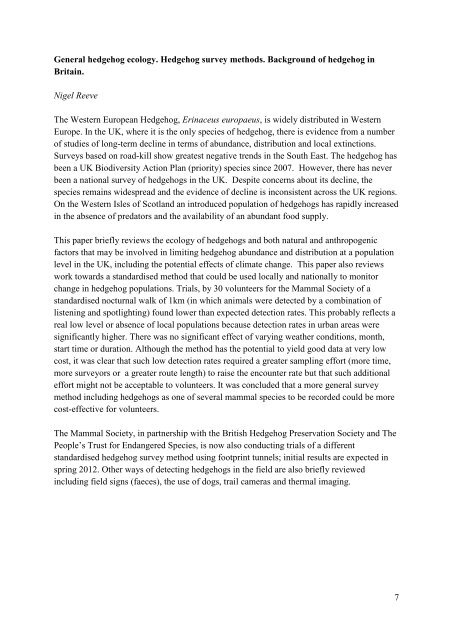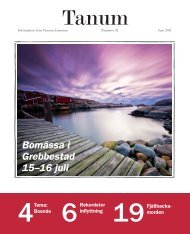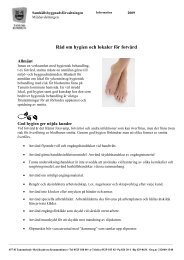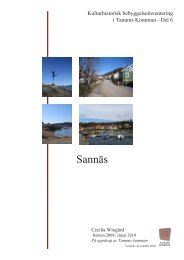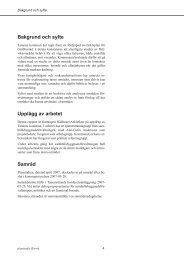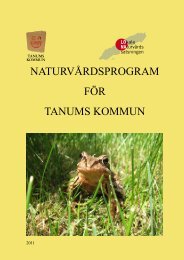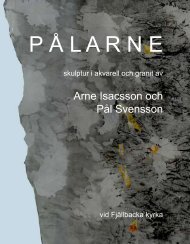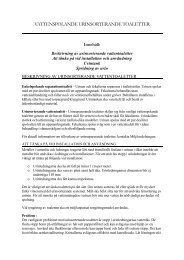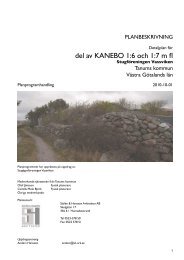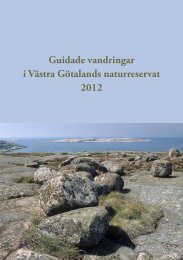Hedgehogs in rural landscapes
Hedgehogs in rural landscapes
Hedgehogs in rural landscapes
Create successful ePaper yourself
Turn your PDF publications into a flip-book with our unique Google optimized e-Paper software.
General hedgehog ecology. Hedgehog survey methods. Background of hedgehog <strong>in</strong>Brita<strong>in</strong>.Nigel ReeveThe Western European Hedgehog, Er<strong>in</strong>aceus europaeus, is widely distributed <strong>in</strong> WesternEurope. In the UK, where it is the only species of hedgehog, there is evidence from a numberof studies of long-term decl<strong>in</strong>e <strong>in</strong> terms of abundance, distribution and local ext<strong>in</strong>ctions.Surveys based on road-kill show greatest negative trends <strong>in</strong> the South East. The hedgehog hasbeen a UK Biodiversity Action Plan (priority) species s<strong>in</strong>ce 2007. However, there has neverbeen a national survey of hedgehogs <strong>in</strong> the UK. Despite concerns about its decl<strong>in</strong>e, thespecies rema<strong>in</strong>s widespread and the evidence of decl<strong>in</strong>e is <strong>in</strong>consistent across the UK regions.On the Western Isles of Scotland an <strong>in</strong>troduced population of hedgehogs has rapidly <strong>in</strong>creased<strong>in</strong> the absence of predators and the availability of an abundant food supply.This paper briefly reviews the ecology of hedgehogs and both natural and anthropogenicfactors that may be <strong>in</strong>volved <strong>in</strong> limit<strong>in</strong>g hedgehog abundance and distribution at a populationlevel <strong>in</strong> the UK, <strong>in</strong>clud<strong>in</strong>g the potential effects of climate change. This paper also reviewswork towards a standardised method that could be used locally and nationally to monitorchange <strong>in</strong> hedgehog populations. Trials, by 30 volunteers for the Mammal Society of astandardised nocturnal walk of 1km (<strong>in</strong> which animals were detected by a comb<strong>in</strong>ation oflisten<strong>in</strong>g and spotlight<strong>in</strong>g) found lower than expected detection rates. This probably reflects areal low level or absence of local populations because detection rates <strong>in</strong> urban areas weresignificantly higher. There was no significant effect of vary<strong>in</strong>g weather conditions, month,start time or duration. Although the method has the potential to yield good data at very lowcost, it was clear that such low detection rates required a greater sampl<strong>in</strong>g effort (more time,more surveyors or a greater route length) to raise the encounter rate but that such additionaleffort might not be acceptable to volunteers. It was concluded that a more general surveymethod <strong>in</strong>clud<strong>in</strong>g hedgehogs as one of several mammal species to be recorded could be morecost-effective for volunteers.The Mammal Society, <strong>in</strong> partnership with the British Hedgehog Preservation Society and ThePeople’s Trust for Endangered Species, is now also conduct<strong>in</strong>g trials of a differentstandardised hedgehog survey method us<strong>in</strong>g footpr<strong>in</strong>t tunnels; <strong>in</strong>itial results are expected <strong>in</strong>spr<strong>in</strong>g 2012. Other ways of detect<strong>in</strong>g hedgehogs <strong>in</strong> the field are also briefly reviewed<strong>in</strong>clud<strong>in</strong>g field signs (faeces), the use of dogs, trail cameras and thermal imag<strong>in</strong>g.7


